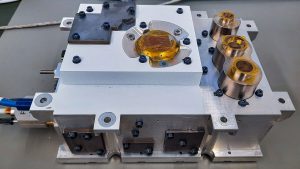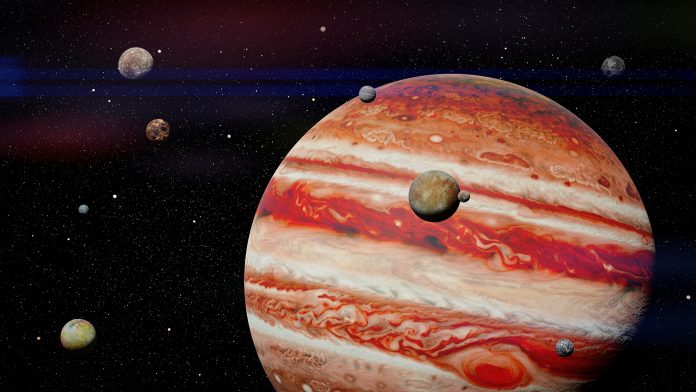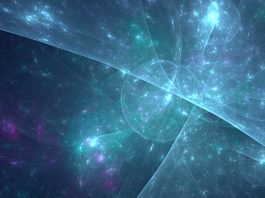The JUICE mission of the European Space Agency ESA, which aims to explore the planet Jupiter and its three largest moons, is now ready to leave Earth.
On board the JUICE mission (Jupiter Icy Moons Explorer) will be the high-tech detector, RADEM, developed at the Paul Scherrer Institute PSI. This will help to provide information about the complex radiation conditions and the highly dynamic magnetic environment of the Jupiter system.
Moreover, the mission will explore three of Jupiter’s largest moons – Ganymede, Callisto, and Europa. Because scientists believe that there may be gigantic oceans and possibly extraterrestrial life underneath the thick icy mantle of these moons, JUICE will answer fundamental questions about the formation of these planetary systems and find out whether Jupiter’s icy moons provide the necessary conditions for the emergence and long-term existence of life as we know it.
The JUICE mission will take around eight years to reach Jupiter’s system. After that, the four-year mission will begin, for which the probe is fitted with 11 extremely complex instruments. One of them was provided by PSI and developed under Wojciech Hajdas’s direction in the Laboratory for Particle Physics.
RADEM is compact and weighs three kilogrammes, looking more like a small car battery than a highly complex particle detector. “RADEM stands for Radiation-hard Electron Monitor, an electron monitor that is resistant to radiation and can detect high-energy particles in Jupiter’s harsh environment,” said Hajdas.
How will the JUICE mission withstand the dangers of Jupiter’s radiation belts?
Jupiter has a rotating liquid metal core that generates a magnetic field like Earth. When charged particles such as electrons and protons enter this field, they are trapped inside and accelerated along spiral paths around the planet. This acceleration is much stronger than on Earth, resulting in high-energy synchrotron radiation, a special form of X-ray.
In addition, atoms and molecules are hurled into space by volcanic activity, which frequently occurs on Jupiter’s moon Io. They become ionised through collisions with the electrons if they acquire an electrical charge and fall under the spell of Jupiter’s gigantic magnetic field.
Because this level of infernal radiation poses a considerable danger to humans and space technology, the JUICE mission’s unique technology has been developed to withstand this. Hajdas stated: “Some parts of the electronics have been developed explicitly for this mission and are highly resistant to radiation. All the equipment in the probe is also specially clad to withstand the extreme conditions in Jupiter’s radiation belts, however, a prolonged stay in certain zones can still lead to damage.”
RADEM is directly connected to the probe’s onboard computer to prevent this. Hajdas continued: “If the radiation dose exceeds certain limits, the detector triggers an alarm signal. As it is difficult to carry out evasive manoeuvres, particularly sensitive equipment can be switched off, protecting it until the radiation levels are back within the permissible limits.”

RADEM’s other task is to map Jupiter’s complex radiation belts and gather information about their environment and the particles they contain. For the JUICE mission, RADEM is equipped with four separate detectors – one for each type of particle: electrons, protons, and heavy ions.
“The fourth detector registers either electrons or protons,” explained Hajdas. “With an angular coverage of about 35%, it allows us to determine the direction of incidence of these particles and hence the spatial distribution of the radiation environment.”
All this data must be processed and stored within a very short time – and inside a tiny space, to keep the device as light as possible.
RADEM can also monitor space weather
Many of the instruments included in the JUICE mission will remain switched off for the eight-year journey into space. However, during the journey, RADEM will remain switched on to measure radiation levels in the Solar System and determine how this relates to solar activity.
“The activity of our Sun follows a regular cycle of about eleven years – during this time, it fluctuates between a period of quiescence and a phase of more frequent solar storms. RADEM should help us to understand these activities better and how they influence our planet and future missions, such as a potential manned mission to Mars,” said Hajdas.
This is why, unlike similar expeditions, the JUICE mission is carried out during a so-called solar maximum. To ensure the detector remains fully functional during this journey and especially during its stay in the Jupiter belt, it had to undergo several stress tests during its development.
Hajdas commented: “With its large research facilities, PSI offers unique opportunities for simulating radiation exposure in space. The Proton Irradiation Facility PIF, the proton accelerator HIPA, and a special vacuum chamber for low-energy electrons allowed us to create conditions similar to those in space and prepare RADEM for its mission in the best possible way.”
Does life exist on Jupiter? The JUICE mission aims to find out
Jupiter’s radiation belts extend several million kilometres into space – the highest particle densities and velocities around the gas giant have been recorded at a radius of around 670,000 kilometres inside the orbit of Jupiter’s icy moon Europa.
A moon travelling along an unreal and icy death zone should be considered a potential habitat for extraterrestrial life. However, while the radiation makes any life on Europa’s surface impossible, it could lead to chemical reactions through interactions with the layer of ice, which would serve as fuel for life. Therefore, the lethal radiation would indirectly provide energy for microbial life – without photosynthesis or the presence of hydrothermal vents.
Hajdas concluded: “The data collected during previous missions and from observations made from Earth have led to numerous speculations and calculations about the existence of life on Jupiter’s moons.
“The JUICE mission will help us to better understand the complex Jupiter system. It’s not a matter of finding life, it’s about gaining a better understanding of the environment to determine whether it is a possible or impossible habitat for life.”









